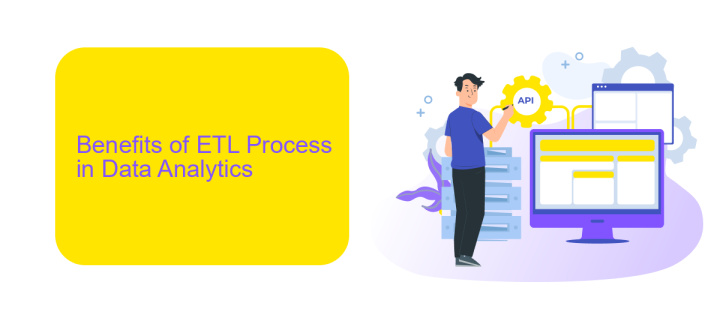ETL Process in Data Analytics
The ETL (Extract, Transform, Load) process is a foundational element in data analytics, enabling organizations to gather data from various sources, transform it into a usable format, and load it into a data warehouse for analysis. This process ensures data consistency, quality, and accessibility, forming the backbone of informed decision-making and strategic planning in today's data-driven world.
Introduction to ETL Process
The ETL process, which stands for Extract, Transform, and Load, is a critical component in data analytics. It involves extracting data from various sources, transforming it into a suitable format, and loading it into a destination system, such as a data warehouse or data lake. This process ensures that data is accurate, consistent, and ready for analysis.
- Extract: This step involves retrieving data from different sources such as databases, APIs, and flat files.
- Transform: During this phase, the extracted data is cleaned, enriched, and transformed into a suitable format for analysis.
- Load: The final step is loading the transformed data into a target system where it can be accessed and analyzed by end-users.
Modern ETL tools and services, like ApiX-Drive, simplify the integration process by providing automated workflows and seamless connectivity between various data sources and destinations. These tools help organizations to efficiently manage their data pipelines, ensuring that data is always up-to-date and readily available for decision-making.
Benefits of ETL Process in Data Analytics

The ETL (Extract, Transform, Load) process offers significant benefits in data analytics by ensuring data is accurately collected, transformed, and loaded into a data warehouse. This process improves data quality and consistency, making it easier for businesses to gain insights and make informed decisions. By automating data integration, ETL reduces the risk of human error and ensures that data from various sources is harmonized and ready for analysis.
Moreover, the ETL process enhances operational efficiency by streamlining data workflows and reducing the time required to prepare data for analysis. Tools like ApiX-Drive facilitate seamless integration of data from multiple sources, making it easier to set up and manage ETL pipelines. This allows organizations to focus on analyzing data rather than spending time on data preparation, leading to faster and more accurate business insights.
Phases of ETL Process

The ETL (Extract, Transform, Load) process is a crucial component in data analytics, enabling organizations to consolidate data from various sources into a centralized data warehouse. This process ensures that data is accurate, consistent, and ready for analysis.
- Extraction: In this phase, data is gathered from multiple source systems, which can include databases, APIs, and flat files. Tools like ApiX-Drive can facilitate seamless data extraction by connecting various applications and automating data collection.
- Transformation: Once the data is extracted, it needs to be cleaned, formatted, and transformed to meet the requirements of the target system. This involves data cleansing, filtering, and aggregating to ensure the data is accurate and usable.
- Loading: The final phase involves loading the transformed data into a target data warehouse or data mart. This step ensures that the data is available for querying and analysis, providing a single source of truth for decision-making.
By following these phases, organizations can ensure their data is reliable and ready for analysis, leading to better insights and more informed decisions. Tools like ApiX-Drive can streamline the ETL process, making it easier to integrate and manage data from diverse sources.
Real-World Applications of ETL Process

ETL (Extract, Transform, Load) processes play a crucial role in data analytics by enabling the seamless integration and analysis of data from various sources. By automating data extraction, transformation, and loading, businesses can make informed decisions based on accurate and timely information.
In the real world, ETL processes are applied across multiple industries to improve operational efficiency and drive business growth. From retail to healthcare, ETL helps organizations manage large volumes of data and derive actionable insights.
- Retail: ETL processes integrate sales, inventory, and customer data to optimize supply chain management and personalize marketing strategies.
- Healthcare: ETL aggregates patient records, treatment plans, and research data to enhance patient care and streamline administrative tasks.
- Finance: ETL consolidates financial transactions, risk assessments, and market data to support regulatory compliance and strategic planning.
Platforms like ApiX-Drive simplify the integration of various data sources by providing automated ETL services. With ApiX-Drive, businesses can connect disparate systems, ensuring data consistency and reducing manual effort. This enables organizations to focus on data analysis and decision-making rather than data management.


Conclusion
In conclusion, the ETL process is a fundamental component of data analytics, enabling organizations to efficiently extract, transform, and load data from various sources into a centralized repository. This structured approach not only enhances data quality and consistency but also facilitates more informed decision-making. By automating the ETL process, businesses can save time and reduce the risk of human error, ensuring that their data analytics efforts are both accurate and reliable.
For organizations looking to streamline their ETL processes, leveraging tools like ApiX-Drive can be particularly beneficial. ApiX-Drive offers seamless integration capabilities, allowing businesses to connect diverse data sources and automate data workflows with ease. By utilizing such services, companies can focus more on analyzing data and deriving insights rather than getting bogged down by the complexities of data integration. Ultimately, a well-implemented ETL process, supported by robust integration tools, is essential for maximizing the value of data in today's competitive landscape.
FAQ
What is an ETL process in data analytics?
Why is ETL important for data analytics?
What are the main challenges in the ETL process?
How can ETL processes be automated?
What are the key components of an ETL pipeline?
Apix-Drive is a simple and efficient system connector that will help you automate routine tasks and optimize business processes. You can save time and money, direct these resources to more important purposes. Test ApiX-Drive and make sure that this tool will relieve your employees and after 5 minutes of settings your business will start working faster.

